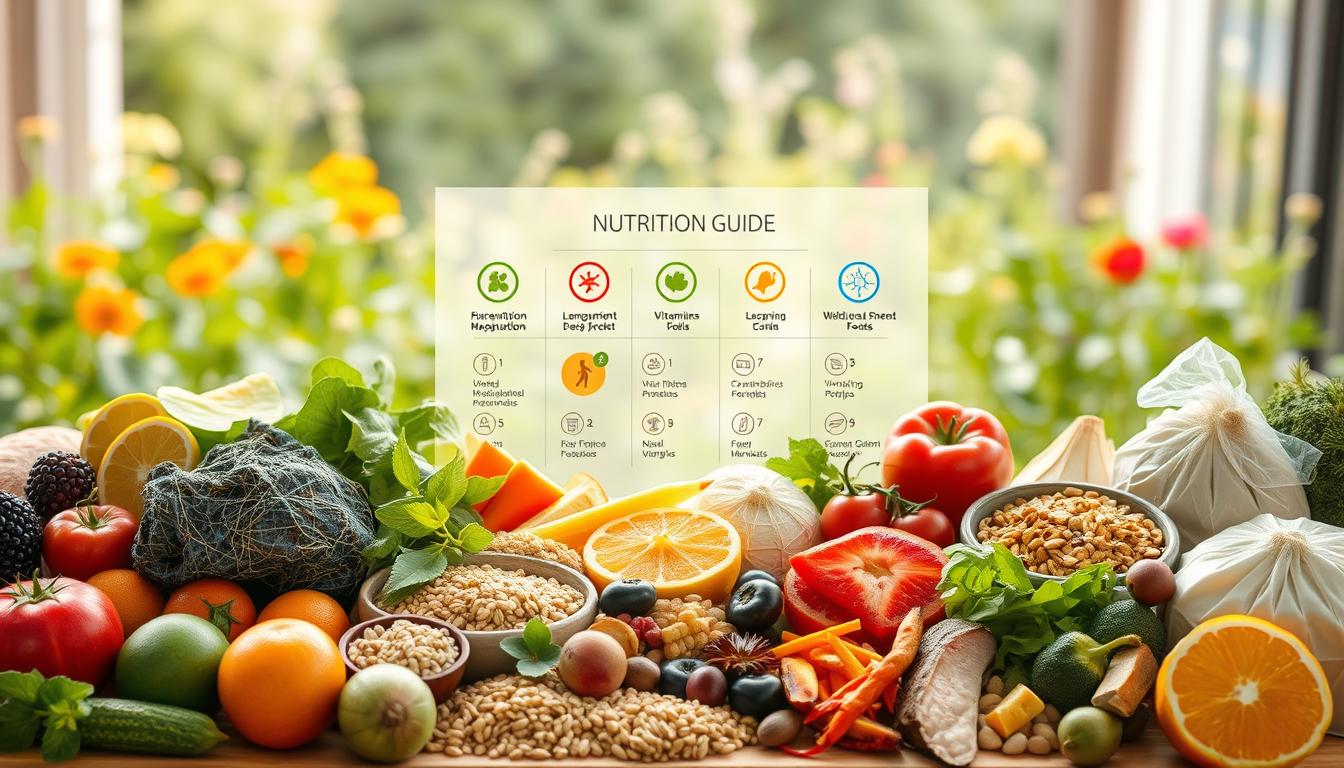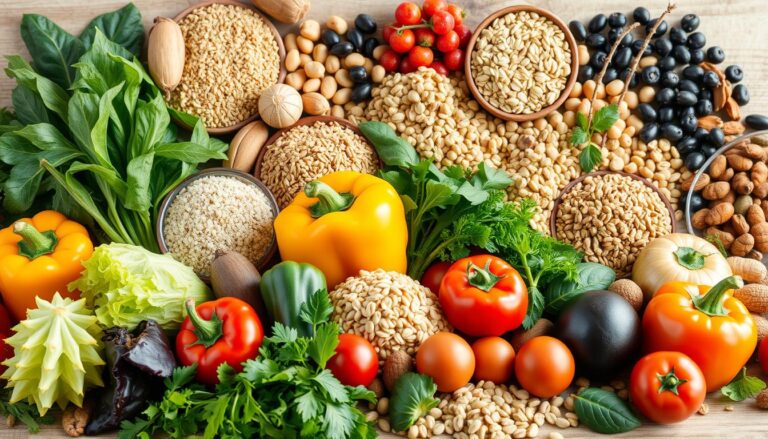Healthy Eating: How to Start Your Journey Today
Table of Contents
Ever felt lost in all the nutrition advice out there? Healthy eating doesn’t have to be hard. It’s about feeding your body with tasty, good-for-you foods that make you feel great.
Nutrition is all about what works for you. There’s no single diet that fits everyone. The goal is to find a healthy eating plan that fits your life, making it easy and fun.
Your body needs nutrients for energy, health, and feeling good. A balanced diet is about making smart, enjoyable choices. It’s not about being perfect, but about nourishing your body.
Key Takeaways
- Healthy eating is a personalized journey, not a one-size-fits-all approach
- Focus on nutrient-dense foods that provide energy and support wellness
- Enjoy your food while making conscious nutritional choices
- Small, consistent changes lead to significant health improvements
- Nutrition should be flexible and adaptable to your lifestyle
Understanding the Importance of Nutritious Food Choices
Your diet is key to your health and wellness. Nutrition helps your body work right, fight off diseases, and keep your mind sharp. Eating whole foods and following clean eating tips can change how you see health.
Good nutrition affects your body and mind. A diet full of superfoods gives your body the nutrients it needs. This supports your body’s many systems.
Impact on Physical Health and Disease Prevention
Choosing the right foods can lower your risk of serious diseases. Studies show that eating whole foods can:
- Lower heart disease risk
- Help manage blood pressure
- Reduce diabetes risk
- Boost your immune system
Connection Between Diet and Mental Wellbeing
Your diet affects your mental health. Clean eating can improve your mood, reduce anxiety, and enhance brain function. Foods rich in nutrients help keep your emotions stable.
Role of Nutrients in Body Function
| Nutrient | Key Functions | Food Sources |
|---|---|---|
| Calcium | Bone strength, muscle function | Dairy, leafy greens, fortified foods |
| Vitamin D | Calcium absorption, immune support | Sunlight, fatty fish, fortified cereals |
| Omega-3 Fatty Acids | Heart health, brain function | Salmon, trout, chia seeds |
Knowing about these nutrients helps you make better food choices. This supports your health and energy for the long term.
The Fundamentals of Healthy Eating
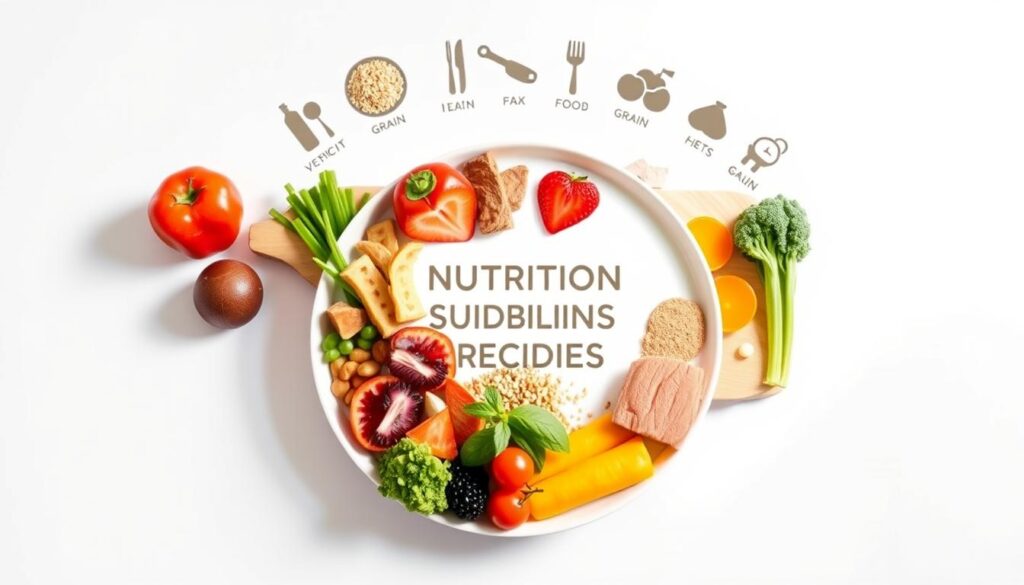
Learning about nutrition basics is key to a balanced diet. It helps keep you healthy. Eating a variety of nutrients is important. They fuel your body and fight off diseases.
Healthy eating starts with three main nutrients: carbs, proteins, and fats. Each is crucial for your body’s health. Aim for a mix of these in your meals for energy and fullness.
- Carbohydrates provide essential energy
- Proteins support muscle maintenance and repair
- Fats contribute to hormone production and nutrient absorption
Nutrient density is a big deal in nutrition. Whole foods have more nutrients per calorie than processed foods. For example, whole eggs are packed with nutrients, unlike processed eggs.
| Nutrient Category | Key Benefits | Recommended Sources |
|---|---|---|
| Proteins | Muscle repair, immune function | Lean meats, legumes, fish |
| Carbohydrates | Energy, fiber intake | Whole grains, fruits, vegetables |
| Healthy Fats | Hormone production, nutrient absorption | Nuts, avocados, olive oil |
Eating whole, nutrient-rich foods is the way to go. It leads to healthy habits for life.
Building a Balanced Plate with Essential Food Groups
Making a balanced plate is key for good health. The MyPlate guide from the U.S. Department of Agriculture helps. It shows how to mix foods for the best nutrition.
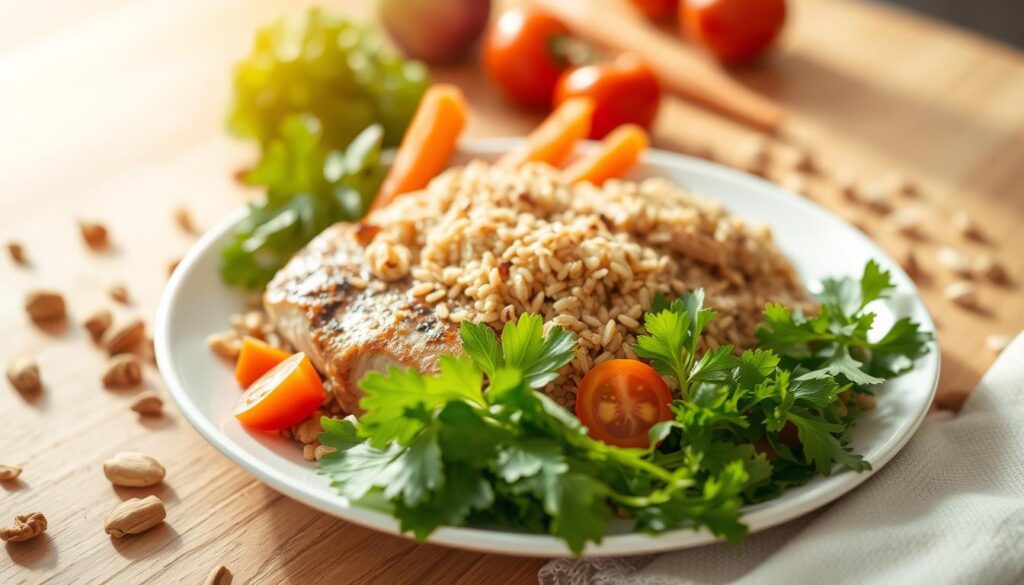
To eat well, know how to spread out your food groups. Fill your plate with a mix of nutrients for better health.
Protein Sources and Portion Guidelines
Protein is vital for muscle repair and feeling full. Here’s what to know about protein:
- Put about 25% of your plate to protein
- Pick lean protein options like:
- Chicken breast
- Fish
- Tofu
- Legumes
- How much protein you need changes:
- Women 19-30: 5-6.5 oz
- Men 19-30: 6.5-7 oz
Complex Carbohydrates and Fiber-Rich Foods
Whole grains give you energy and important nutrients. Choose plant-based carbs for the best nutrition.
- Go for whole grains like:
- Brown rice
- Quinoa
- Whole wheat bread
- Try to eat 6-8 oz of grains a day
- Make sure half of your grains are whole
Healthy Fats and Their Benefits
Healthy fats help your body absorb nutrients and keep your brain sharp. Add small amounts of good fats to your meals.
- Good fats include:
- Avocados
- Nuts and seeds
- Olive oil
- Fatty fish
- Use healthy fats in small amounts
- Choose quality over quantity
Smart Shopping: Stocking Your Kitchen for Success
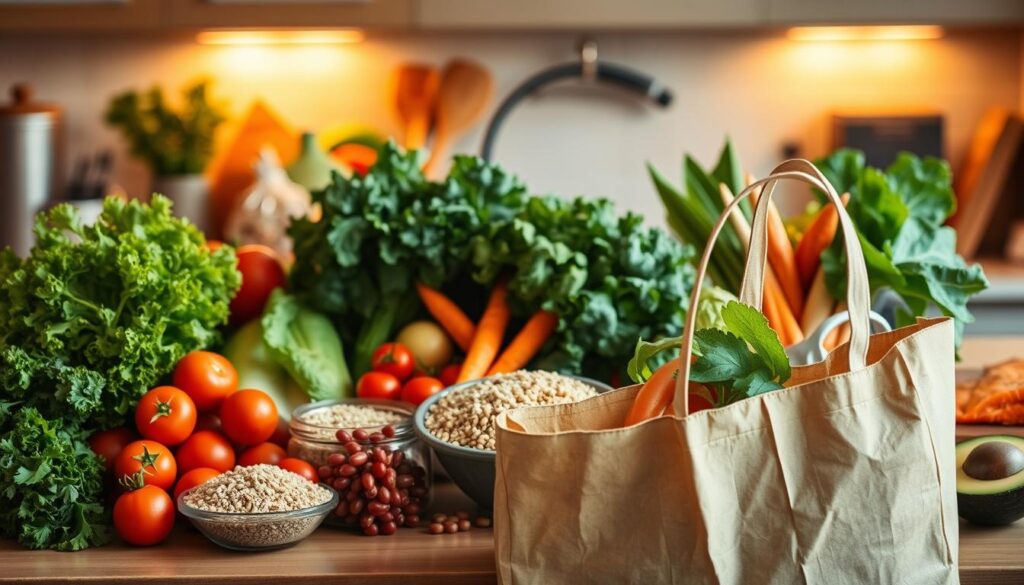
Turning your kitchen into a clean eating haven starts with smart grocery shopping. The World Health Organization suggests eating five servings of fruits and veggies daily. This makes choosing healthy foods key to your health journey.
When planning meals, pick nutrient-rich superfoods for the best nutrition. Your shopping list should include:
- Fresh and frozen fruits and vegetables
- Lean protein sources like chicken, fish, eggs, and tofu
- Whole grains and complex carbohydrates
- Healthy fat sources such as avocados and olive oil
- Nutritious snack ingredients like nuts, seeds, and dried fruits
Studies show 70% of people save money by planning meals weekly. Tip: never shop on an empty stomach – it can lead to up to 30% more impulse buys!
Stick to the outer aisles of the store for the healthiest items, about 60% of them. Look for products with the Heart-Check mark for good nutrition. When buying packaged foods, check the ingredient list. Whole grains should be first for the best nutrition.
Your kitchen is your health headquarters – stock it wisely!
By using these smart shopping tips, you’ll make your kitchen a clean eating haven. It will make cooking healthy meals easy and fun.
Meal Planning and Preparation Strategies
Learning to plan meals can change how you eat clean and follow dietary guidelines. It makes meal prep easier, saves time, and helps you meet your nutrition goals.
Weekly Meal Planning Foundations
Meal planning doesn’t have to be hard. Here are some simple tips:
- Make a flexible weekly menu that fits your schedule
- Choose recipes that use the same ingredients to cut down on waste
- Plan meals that everyone can enjoy, even if they have different tastes
Time-Saving Preparation Techniques
Make cooking faster with these smart tips:
- Cook proteins and grains when you have more time
- Try sheet pan meals for quick, healthy dinners
- Get kitchen tools that make prep work quicker
Smart Storage and Organization
Good storage keeps your ingredients fresh and ready. Studies show that 85% of meal planners save a lot of time by cooking ingredients in bulk. Here are some storage tips:
- Use clear, labeled containers to find ingredients easily
- Prep veggies and proteins ahead of time
- Use a system to keep food from going bad
Pro tip: 75% of meal preppers say using ingredients in different meals saves money and makes planning easier.
By using these meal planning tips, you’ll make clean eating a part of your life without hassle.
Understanding Portion Control and Serving Sizes
Learning about portion control is key to a balanced diet. It starts with knowing the difference between serving sizes and portion sizes. A serving size is what’s listed on nutrition labels. A portion is how much you actually eat.
Research shows interesting facts about portion sizes and eating habits. People often don’t know the right portion sizes, which can lead to eating too much. The portion size effect shows how easy it is to eat more calories than we should.
Recommended Serving Guidelines
- Vegetables: 2½ cups daily
- Fruits: 2 cups daily
- Grains: 3-6 servings (at least half whole grains)
- Protein: 1-2 servings (5½-8 ounce equivalents)
Visual cues can help manage portions. Experts suggest using smaller plates to eat less. A 2023 study showed that using lighter bowls helps with mindful eating.
| Food Group | One Serving Example | Recommended Amount |
|---|---|---|
| Vegetables | 2 cups raw leafy greens | 2½ cups daily |
| Protein | 3 ounces cooked meat | 5½-8 ounces daily |
| Grains | 1 slice whole-grain bread | 3-6 servings daily |
Tracking what you eat is a great way to follow dietary guidelines. Keeping a food diary can help with weight management and nutrition awareness.
Your portion control strategy is key to achieving a healthier lifestyle and maintaining optimal nutrition.
Making the Switch from Processed to Whole Foods
Switching to whole foods can greatly improve your health and wellness. Clean eating is about making better choices. These choices give your body the nutrients it needs.
First, learn the difference between processed and whole foods. Whole foods are natural and full of nutrients. They help your body work its best.
Identifying Ultra-Processed Foods
Ultra-processed foods have many artificial ingredients and little nutrition. They include:
- Packaged snack foods
- Sugary beverages
- Frozen prepared meals
- Processed meats
- Refined grains
Healthy Substitution Guidelines
Changing to whole foods doesn’t have to be hard. Start with small swaps. Add more superfoods to your diet.
| Processed Food | Whole Food Replacement |
|---|---|
| Potato chips | Raw nuts or seeds |
| Soda | Sparkling water with fruit |
| White bread | Whole grain bread |
| Sugary breakfast cereal | Oatmeal with fresh berries |
Reading Nutrition Labels
It’s important to learn how to read nutrition labels. Look for short, simple lists. Avoid artificial additives.
*”The best diet is the one that makes you feel great, fuels your body, and brings you joy.”*
Your journey to whole foods is personal. Be kind to yourself. Celebrate every small success in your clean eating journey.
Creating Sustainable Eating Habits
Building sustainable eating habits is more than just trying new diets. It’s about making smart choices every day. You make about 200 food decisions daily, which can be a lot. Mindful eating helps you make these choices with care and attention.
Creating plans for your eating habits can really help. Studies show that planning specific actions leads to better habits. This way, you can make healthy eating a part of your life without feeling forced.
A good nutrition plan is all about doing the same things over and over. At first, it takes a lot of effort. But soon, it becomes second nature. Celebrate small victories, like eating whole grains or adding veggies to your meals, to keep you going.
Your journey to healthy eating is about making progress, not being perfect. Knowing how your food choices affect your health helps you stay flexible. See mindful eating as a way of life, not a strict rule. This will change how you view food.
FAQ
What exactly is considered a “healthy diet”?
A healthy diet is about eating a variety of whole foods. These foods give you the nutrients you need. They help keep you physically and mentally healthy.
It’s about eating fruits, vegetables, lean proteins, whole grains, and healthy fats. Try to avoid processed foods, added sugars, and too much sodium.
How can I start eating healthier without completely overhauling my diet?
Start with small, easy changes. Add more whole foods to your meals. Eat more vegetables and drink water instead of sugary drinks.
Slowly replace processed snacks with healthier options. Remember, it’s about progress, not being perfect. Make changes you can keep up with.
Are superfoods really necessary for a healthy diet?
Superfoods are packed with nutrients, but they’re not the only thing you need. Eating a variety of whole foods is more important. Include foods like berries, leafy greens, nuts, and fatty fish for their health benefits.
But don’t think they’re a magic solution. They’re just part of a balanced diet.
How important is meal planning for healthy eating?
Meal planning is key for a healthy diet. It helps you make better food choices. It reduces impulse eating and saves time and money.
It ensures you get the nutrients you need. By planning, you’re more likely to eat healthy meals and avoid unhealthy options.
Can I eat healthy on a budget?
Yes, you can! Focus on affordable foods like beans, eggs, frozen veggies, and whole grains. Buy fruits and veggies in season and generic brands.
Use store loyalty programs and buy in bulk. Cooking at home can save money and support healthy eating.
How do I manage portion sizes effectively?
Use your hand as a guide for portion sizes. A palm-sized portion is good for proteins, a fist-sized portion for veggies. Use a cupped hand for grains and a thumb-sized portion for healthy fats.
Eat slowly and listen to your body’s hunger cues. Using smaller plates can also help control how much you eat.
What are the best proteins for a healthy diet?
Choose a mix of lean animal proteins like chicken, fish, and turkey. Also, include plant-based proteins like beans, tofu, and quinoa. Fish like salmon is great for omega-3s, while beans and lentils offer fiber and nutrients.
Try to get protein from both animals and plants for a balanced diet.
How can I transition from processed to whole foods?
Start by reading food labels and slowly switch to whole foods. Choose fresh fruits over fruit snacks and whole grains over refined carbs. Opt for homemade meals over packaged ones.
Make small changes and focus on adding healthy foods, not just cutting out bad ones.
What are some quick healthy meal preparation tips?
Batch cooking is a great time-saver. Use tools like slow cookers and instant pots. Chop veggies ahead of time and prepare overnight oats.
Cook big batches of grains and proteins. Keep a pantry stocked with quick, healthy ingredients like canned beans, nuts, and whole grains.
How do I maintain motivation for healthy eating?
Set achievable goals and track your progress. Celebrate your small wins and be gentle with yourself. Focus on how good you feel, not strict rules.
Try new recipes, involve friends or family, and remember consistency is more important than being perfect.

